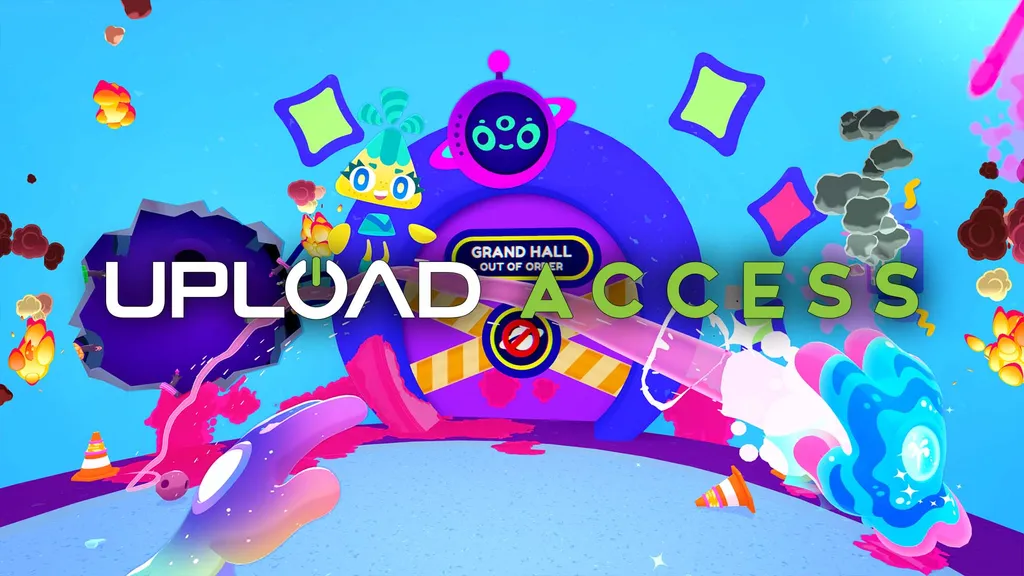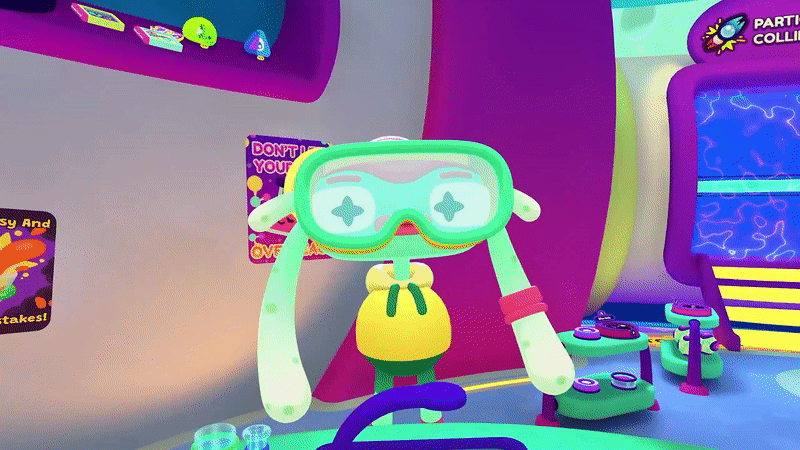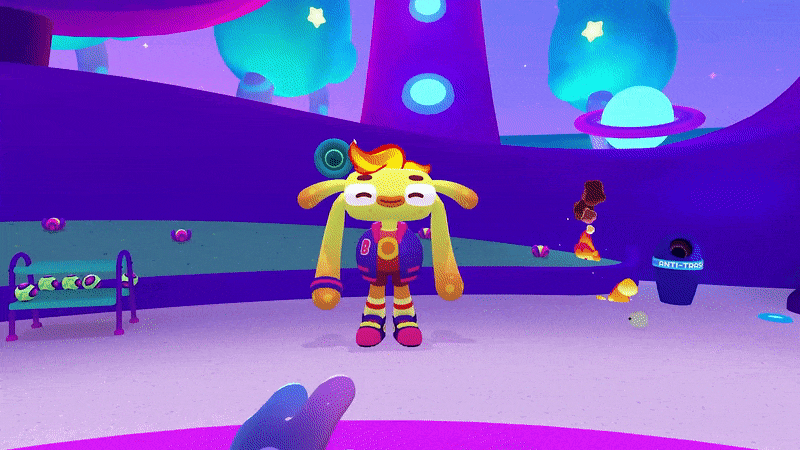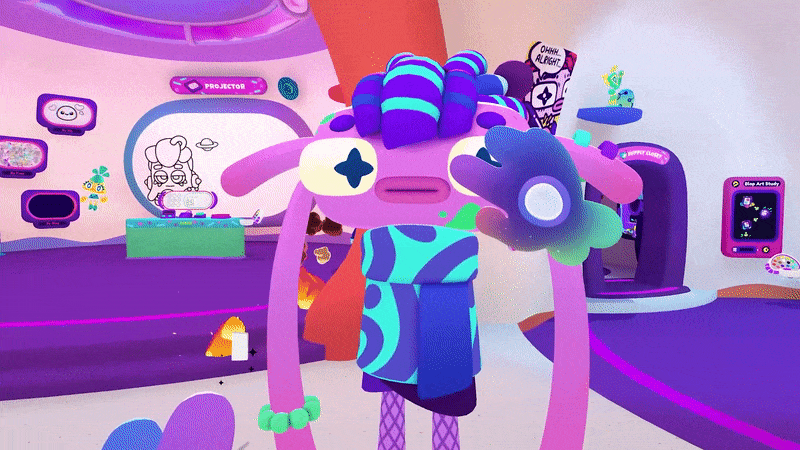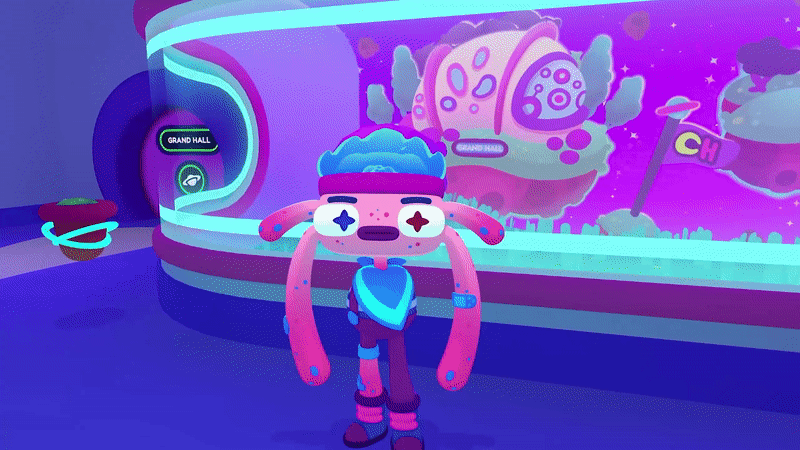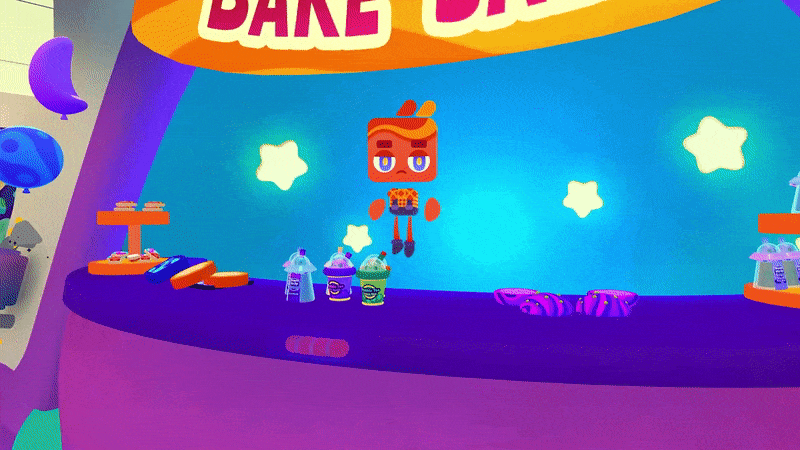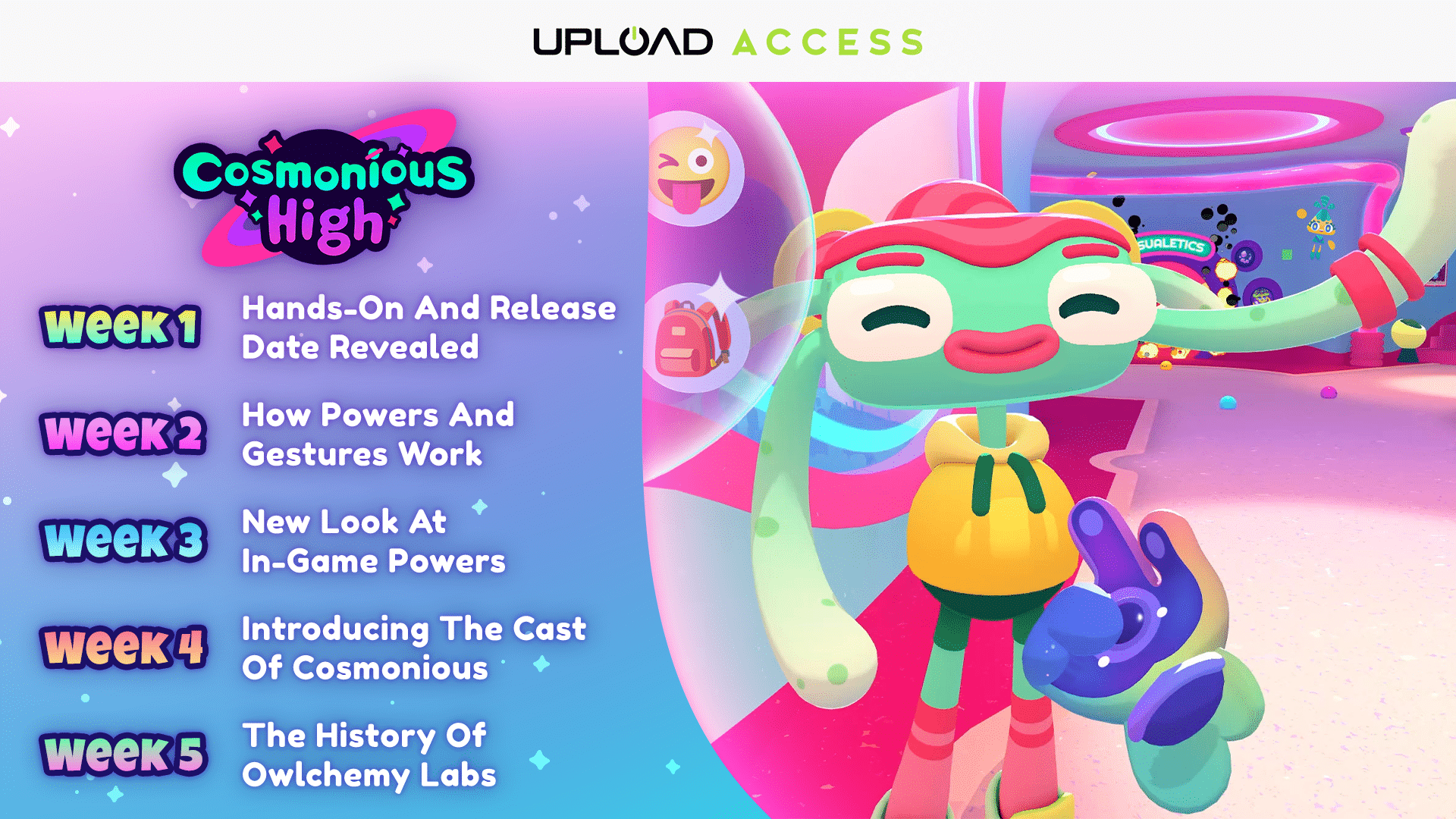Owlchemy Labs doesn’t believe in shortcuts.
It’s six years into the launch of consumer VR and, in that time, the team has put out three games with its fourth, Cosmonious High, just a few weeks away. Like Job Simulator, Vacation Simulator, and Rick and Morty: Virtual Rick-ality before it, Cosmonious is a typically light-hearted showcase of new immersive design ideas and concepts that refuses to adhere to some of the trends that have arisen in other games in the VR landscape in recent years. These are trends that tend to fast-track more traditional gaming concepts like fast movement, which might cater to hardcore, long-time VR gamers, but risk leaving the wider, more casual and first-time audience nauseated.
“We’ve got to remember that today we’re getting more new players into VR than we are getting former players,” says Andrew Eiche Chief Operating Owl (not a typo, it’s a thing they do). “This game is one of our most complex games […] I’m not saying we’re making it for absolutely the greenest players. We still can’t forego that, like, maybe somebody playing Cosmonious High has played Beat Saber and Job Simulator and this is the third game they played. Or maybe it’s the first, but we’re really focused on that.”
“The way we think about things is there’s stuff for everybody,” Devin Reimer, Chief Executive Owl (still not a typo) later adds. “And if somebody comes into VR and they just play our games in order, they’re actually going to have a great onboarding experience to VR in general. And so instead of us building games that are trying to compete with other games that we have made, here’s just like a really awesome onboarding ramp to what VR has to offer.”
Cosmonious might be seen as the culmination of all of Owlchemy’s work thus far. Job Simulator introduced you to VR interactivity, Rick and Morty explored VR characters, Vacation Simulator fleshed out bigger, more varied worlds, and Cosmonious now revisits each of those core tenets, expanding upon them. “Cosmonious High is now more about cross-interactivity in the world and looking at building this much more open environment as well as having deeper character interactions,” Eiche says.
The game’s origins date back to the development of the original Job Simulator, which the pair reveal very nearly had a fifth job in the form of a teacher mode. “We were right on the cusp of putting it in Job Simulator and ran out of time,” Eiche says. “It was probably one of the most fully realized things. And then we were like, ‘Eh, it’s just not going to make it.'”
After shipping Vacation Simulator in 2019, the team knew it wanted to revisit the idea of school and the new concepts it might introduce. Specifically, the studio was interested in the idea of friends and how to communicate with them. To that end, Cosmonious has a conversation system that’s given the expected Owlchemy spin. Instead of lines of dialogue to read and then select, you simply choose a response from a series of emojis. “We wanted a system where you felt expressive,” Eiche explains. “So in our case, emojis are the language that many of us use today to speak, so we understand what those mean, but also that didn’t feel prescriptive.”
In order to have meaningful conversations, though, you’ve got to have believable characters. Traditional techniques like scripted mocap and canned animations, Reimer believes, haven’t served VR very well thus far. It feels as if you’re “in a museum exhibit where there’s…an animatronic,” he says. “And it’s not that the mocap is bad. It’s just in real life, people play off of you, right? Their head tilts towards you. When you gesture towards them, they interact. It’s not this boxed unit that plays the same every time. And so that was super important when we started working on these characters was to build out all these systems that allowed them to be dynamic.”
Cosmonious’ cast of students, then, are wide-eyed critters conveniently missing tricky animation points like, y’know, elbows. They’re made up of a complex set of layers to determine their responses to you and your actions. Eiche explains that they have members of the Owlchemy team go in to act out lines of dialogue “like puppetry”, with Owlchemy’s tech then interpreting how it should also shift in the given context.
“It allows for this really cool emergent stuff,” Reimer says. “Like the other day I was playing and Fren, one of the alien characters, was in Chemistry and went and grabbed a glass and then put it under the tap to fill it up with water. And then I toss something and then [she] caught it with the other hand and looked at it while still holding the glass […] The amount of systems that played together to make that piece of like performance art is pretty incredible, but it just feels so natural.”
But characters are only one part of Cosmonious High’s makeup. The more immediate part of the game is your character’s ability to summon supernatural powers, like shooting water or ice, and then applying them to lessons and tasks that make up short, approachable objectives a little like the ones seen in Vacation Simulator. I said in my preview last week that there was a promising start to be seen with these powers in the game’s opening 30 minutes, but was waiting for it to really open up and let me start putting it through its paces to see what the system could do.
Eiche says that will happen as you unlock new abilities — fire and wind powers were just revealed — and start looking to combine powers. “I think that’s really where a lot of the interesting things start happening is when you get this where you’re like, okay, what happens if I mixed the ice power and the water power? Oh, it shoots ice cubes. That’s really cool. And then, how can I use this in a different way?”
This, Reimer says, also highlights the emergent side of gameplay. One developer was “shooting water and they’re shooting ice,” he recalls. “So then the water streamed frozen ice cubes, but the water in their hand was actually a fluid that makes things edible. So then the ice cubes were edible and they bounced on the floor. And then our little alien Blebs bounced around and they’re like, “Ooh, food!” And they’re chomping on it and it’s just it’s all of those systems just playing together.”
And, sure enough, I find some off-the-cuff fun in spraying fellow classmates with water (which they instantly gurgle) or drawing hats on them with the Tilt Brush-like crystal power. But this level of freedom does open Cosmonious up to a less desired avenue: bullying the virtual characters. How does Owlchemy approach that?
“It’s best to leave it alone,” Eiche replies. “So this goes all the way back to Rick and Morty. We’ve had this exact debate. And what we found is best is to acknowledge things as funny. Our games are inherently nonviolent, right? So we’re already off to a good start. You don’t have the whole like, ‘Oh, I only have guns for hands, let me shoot every NPC’ problem that you get in a lot of other games.'”
“We have two choices, we could defuse and have some fun with it, or we can ignore. We pretty much just pick one of the two based on what works better. So the gurgling sound is like a defuse. It’s funny, they got it. They’re drinking the water, thanks, we’re good. And then if they’re hitting them, if you’re trying to hit them really hard, they’re just not reacting because any reaction at all is encouragement. That’s the point of trolling, right? The whole concept of trolling is that you are seeking a negative. So just no reaction is ‘Oh, the game’s not gonna play with me in that space, so I’m just not going to go there.'”
As alluded to above, another area Owlchemy is steering clear of is smooth locomotion. In six years of big releases, none of Owlchemy’s games have used this feature, instead relying on room-scale movement or teleportation, and that’s only if any movement is needed at all. The studio stands almost alone in this category now – even big games with teleportation at their core like Budget Cuts have added in this option. But smooth movement, as we all know, can make players sick. So why not include it as an option for those that want it?
“The concept of options implies that somebody’s paying attention to the options,” Eiche says, referring back to those first-time users. “And that’s a problem for us because we want to make sure that we are keeping people from getting sick.”
This is something Owlchemy stands firm on. Eiche even says that, if you can’t “tough it out” with teleportation, then you might want to skip Cosmonious. “There are lots of games on the Oculus store that only do smooth locomotion,” he says. “So if that’s really a deal-breaker for you then maybe this just isn’t the game for you.”
There’s crucial technical reasoning behind the move too, as Reimer explains: “We leverage the ability to tell teleport to actually make the game possible. So as you’ve experienced we have this splat system that allows you to color and paint every surface in the game in a way that some people say is like Splatoon. We’re running this on a mobile chipset at high frame rates in VR. And that is very wild.
“But part of the way that we can get that to work is that we have systems like, for example, when you teleport — and we use this all the time throughout our game — when the game fades to black, [we] re-do so much work that the CPU goes up to max and we go through, we rebuild meshes around you to make sure you have very high quality [in] the interactive areas that you can splat around you. We have systems like we have our custom LOD [level of detail] system that goes in and swaps those things out.”
On the flipside, Cosmonious also places less of an emphasis on room-scale movement. It’ll work still, but Eiche says the team’s seen the trends on how often this approach is actually used. “It just made more sense to see where everyone was going,” he reasons. “And…this kind of more discrete teleportation is what people like, and it allowed us to be more free with the levels.”
There’s a lot that’s different about Owlchemy’s approach with Cosmonious High, then, but one thing that hasn’t really changed is the tech it’s playing with. Yes, the industry has introduced standalone systems but the core platform of one headset and two tracked controllers remains largely standard. New tech, however, is on the rise: Quest’s hand-tracking feature (which was added into Vacation Simulator) continues to improve, and Project Cambria promises to bring eye and face-tracking into the fold too. Owlchemy doesn’t plan to implement these features in Cosmonious right now, but it’s watching and working on them with a keen if cautious eye.
“From my standpoint, I’m convinced [hand-tracking] is a huge part of the future,” Reimer says, noting how much more seamless the experience can be for new users, not to mention developers constantly putting down controllers and losing them.
As for Cambria’s new features? “Face tracking is very interesting,” Eiche says. Then there’s a plot twist: “Eye tracking is mildly interesting.”
For social, the developer says, both features will be incredible additions to the VR ecosystem. But Eiche believes eye-tracking won’t be hugely beneficial for input. “Eye-tracking is terrible for user experience,” he says. “And the reason why is — and this is what I challenge you to do — pick like a letter on a page. I did a demo like this– at a booth, won’t name any names — with an eye-tracking demo and stare at it for five seconds and don’t move your eyes. That’s not how eyes work.
“The thing that they never showed in the Superman movies is the fact that your eyes move around all the time and that it would just be this horrible thing to have with laser beam eyes,” Eiche jokes.
Reimer agrees, adding that our bodies are naturally inclined to turn our heads to what we’re looking as so it’s in the center of our vision. “But eye-tracking, combined with face-tracking for social, I think that is one of the big missing pieces moving into the future. And I think that people don’t realize that because they haven’t had it yet to understand kind of the ramifications of that coming into play.”
That’s all future talk, though, and we know what Owlchemy thinks about shortcuts. Cosmonious High will represent what the team thinks VR is capable of in 2022, and we’re looking forward to digging into what its latest playground really has to offer.
Cosmonious High releases on PC VR and Quest 2 on March 31.

